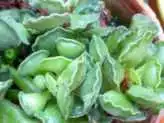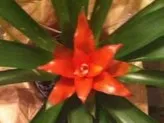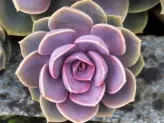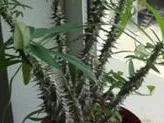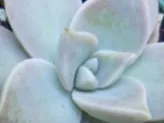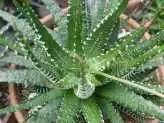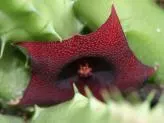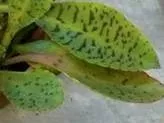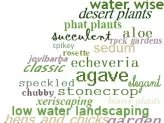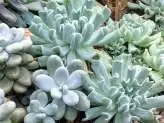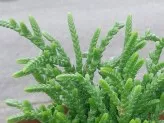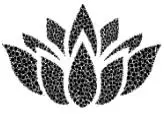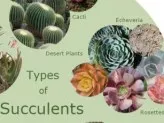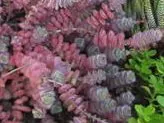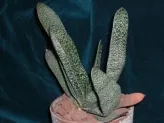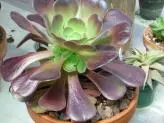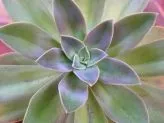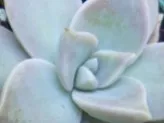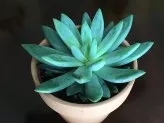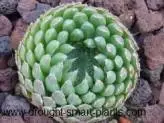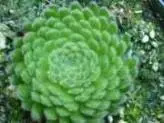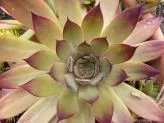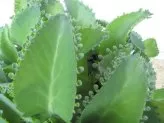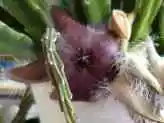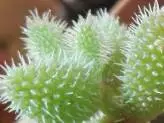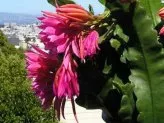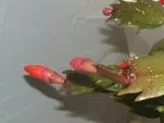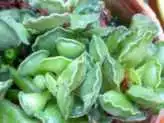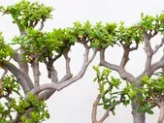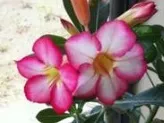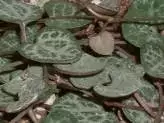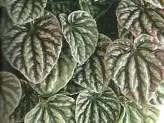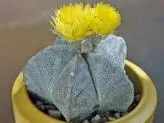This Succulent Identification Chart can help you find your plant: check the general description for some similar plants.

Click on the pictures below for more about each different plant – there are so many of them!
Luckily for us, succulents come in all shapes and sizes.
Notice whether your plant is spiky, chubby, rosette-forming or even has baby plants hanging from the edges of the leaves to guide you to more information on similar plants.
The many types of succulents that you can find in nurseries, garden centers, as a cutting from a friend or in large box stores is absolutely astounding.
If you’re identifying succulents to find out more about how to grow them successfully, this chart might help narrow down your search.
Identify your succulent by:
- shape (strappy or spiky leaves)
- growth habit (rosette forming)
- by peculiar and unique distinguishing characteristics ( babies growing on the edges of the leaves).
Look at the descriptions below, and see if your plant fits into one of the categories; then go through the examples to find your plant.
Still no luck? Check out these pages for more.
Spiky Leaf Succulent Plants
Grass Like or Fleshy
If your plant has spikey leaves with small teeth along the edges, look at Aloe; click on the pictures for more images.
Smaller species and varieties of Aloe are commonly grown as house plants, and in areas that don’t get frost – or much anyway, these are great garden and landscape plants too.
Where they are allowed to spread and develop their full shape and size, they will bloom with a tall flower spike with bell like blooms in shades of red, pink and peach. Hummingbirds are attracted to these flowers in droves.
As an added benefit, they are fire resistant.
See the full selection of spiky leaf succulents, and see if yours is in there.
Agave look similar to Aloe, but generally have a wicked spike on the end of every leaf. However, your plant might not show these as they are sometimes cut off in the nursery before sale.
Other giveaway traits are the water marks, or lines on the leaves left by the previous layer of leaves. These are desirable and beautiful markings.
Gasteria can be smooth or pebbly but never have much in the way of armament, or spines. The edges of the leaves, although sharp, are not toothed.
The flowers of Gasteria look like a tiny stomach, hence the name of the plant.
This is one plant that you don’t pay any attention to… until it flowers.
The blooms look more like fancy earrings than flowers, made out of delicate and intricate pieces.
Tender Rosette Forming Succulents
Rose Like Shape, Circular Succulent Plants
Aeonium have two dormancy periods to help them survive long hot summers with little water; this requirement means that they could look a little shabby in the late summer, but they’ll recover in the fall to flourish again.
Echeveria are a favorite rosette forming succulent, although some may start out as a short rosette close to the ground, only to end up with a long stalk and a clump of leaves on top.
There is a cure for this, which you can find out more about here.
Graptopetalum are a similar and related plant to Echeveria, and in fact are so closely related that they actually hybridize to form the intergeneric hybrid x Graptoveria.
And then there are all the generic hybrids – these are crosses between two genuses of plants, like Sedum and Echeveria, which produces x Sedeveria, and Pachyphytum and Echeveria, to form x Pachyveria, to name a few. If your plant doesn’t look like either, or looks like a combination of two different plants based on the characteristics, this is most likely what you have.
Hardy Rosette Forming Succulents
Winter Hardy Succulent Plants
Jovibarba are sometimes ‘lumped’ in with Sempervivum and called Sempervivum jovibarba. This makes for some confusion, as although they are similar in habitat, growth habit and care, they do have some unique characteristics.
Many of the smaller species carry their propagules high up over their backs on brittle threads which can break easily and release the tiny chicks which roll away to root a distance from the hen. They are known as ‘rollers’ for this habit.
Jovibarba heuffelii is another related plant, with a significant difference in the way it is propagated; the crown itself splits into several new plants, all joined at the base. Eventually, it can make a considerable colony, all from a single plant.
Orostachys is an odd genus; the plants are hardy, drought tolerant and have some unique traits among hardy succulents.
They have been known to continue to grow even under extremely cold conditions, but they are also very sensitive to excess moisture at certain times of the year.
If you’re lucky enough to have a few of these in your garden, cherish them; at any moment they could decide they dislike the conditions.
Rosularia have been grown by avid rock garden enthusiasts and collectors for a long time, but you seldom see these plants for sale.
It could be that due to their common habit of being biennial the rosettes all tend to bloom at once, after which they die.
Having an area which is undisturbed so that the next generation can grow from the seeds that the parent plant drops is the only way to keep a colony going.
Ah, Sempervivum; my favorite hardy succulent! These lovely and easy to grow plants grace my xeric garden with their gorgeous ever changing colors and textures, and using them in succulent crafts has been nothing but pleasure.
The amazing variety and wondrous textures of a carpet of them is not to be forgotten.
See more winter hardy succulents here and more on rosette forming succulents, hardy and tender.
Sedum, or stonecrop, come in an infinity of forms. If you’re not sure what you’ve got, check here. Most Sedum are low growing, creeping and drought tolerant. Some, however, are more like a shrub.
Reproductive Leaves
Baby Plants on a Leaf
If your succulent has babies growing on the edges of the leaves, it could be one of the Kalanchoe species, many of which have this odd characteristic.
I get so many questions about the Kalanchoe plant that has babies growing on the edges of the leaves. Find yours at my affiliate!
Stinky Flowers
The Flowers Smell Like Rotting Meat
These two are both called Carrion Flowers, after the distinctive smell of rotting meat that the flowers give off as they open.
This interesting and icky habit has a use; it attracts flies to the flower for pollination to set the seed.
Huernia (top image) have odd bumpy modified stems with a rubbery texture, and Stapelia (bottom) have four cornered stems with little soft bristles.
One of the most endearing traits of these interesting plants is the protective prickles, fuzz or velvet.
Find out which plants make you want to pet them.
Flat Leaf Succulents
Brightly Colored Flowers
Modified flat ‘leaves’ which are actually stems, either straplike, or jointed like crab legs. The flowers are spectacular and short lived – some open only at night, such as with Queen of the Night, and the only sign of them opening is the strong fragrance.
Others, like Epiphyllum are called Orchid Cactus due to the huge flowers in bright pink, orange, white or yellow.
Schlumbergera is the Christmas Cactus, one of the Holiday Cactus group, which open in late fall until early spring, depending on the genus and species.
Pebble Plants
Lithops are pebble plants and look just like little round pieces of gravel. This is mimicry in action.
There are several other similar plants that look this way, all needing fairly strict routines. They are particularly sensitive to excess water.
Round Leaf Succulents
Rounded Leaves, Some Hardy, Some Not
Cold Hardy taller Sedum, otherwise known as Stonecrop is a common garden plant, but it comes in many guises. There are several forms, and lots of different cultivars.
The little ‘key lime plant’ looks like it’s made of tortoise toes. It also goes by the name of Baby Toes, for obvious reasons.
Crassula is the Jade Plant that everyone knows. Tough and reliable, this plant has been around for years – but there are new ones that aren’t so easy to recognize too.
Portulacaria afra is the Elephants Food – an uncommon name for a great little plant.
There are many different varieties to choose from – the plain green one is only the start.
Also known as Desert Rose, the Adenium are a very addictive plant – consider yourself warned. The plants from cuttings will bloom sooner than those from seed, but the cutting propagated ones don’t grow the interesting thickened stem. It’s a toss up…
Ceropegia woodii is the tongue twisting name (appropriately) of Hearts Entangled. Although the stems are slender and thin, the leaves are fleshy, and it’s got little tubers – hence, a succulent.
Pepperomia is a huge genus – lots to choose from there.
The leaves are sometimes pleated, and other times thick and succulent, often variegated.
Aptenia cordifolia is often used as a ‘filler’ to add some bulk to mixed planters, and it’s often the only one to survive.
Just goes to show that the delicate looking ones are tough too!
Other oddly shaped plants;
Astrophytum myriostigma is the Bishops Hat cactus – ‘astro’ means ‘star’ and you can see where that name comes from when you realize the star shaped arrangement of the leaves – added bonus; lightly scented flowers!
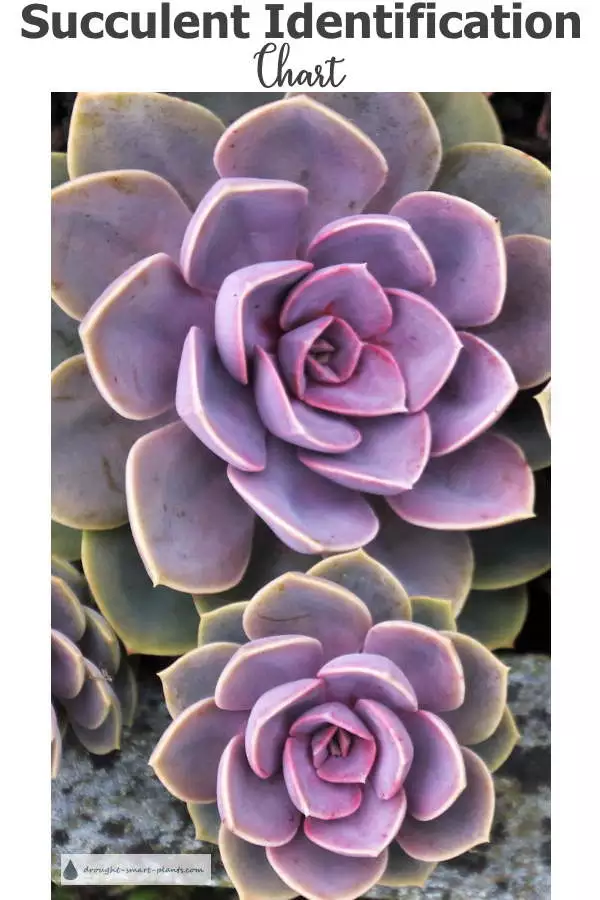
As an Amazon Associate, I earn from qualifying purchases.
Other links on this site may lead to other companies that I’m associated with.





